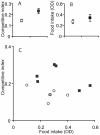Adaptation to abundant low quality food improves the ability to compete for limited rich food in Drosophila melanogaster
- PMID: 22292007
- PMCID: PMC3265517
- DOI: 10.1371/journal.pone.0030650
Adaptation to abundant low quality food improves the ability to compete for limited rich food in Drosophila melanogaster
Abstract
The rate of food consumption is a major factor affecting success in scramble competition for a limited amount of easy-to-find food. Accordingly, several studies report positive genetic correlations between larval competitive ability and feeding rate in Drosophila; both become enhanced in populations evolving under larval crowding. Here, we report the experimental evolution of enhanced competitive ability in populations of D. melanogaster previously maintained for 84 generations at low density on an extremely poor larval food. In contrast to previous studies, greater competitive ability was not associated with the evolution of higher feeding rate; if anything, the correlation between the two traits across lines tended to be negative. Thus, enhanced competitive ability may be favored by nutritional stress even when competition is not intense, and competitive ability may be decoupled from the rate of food consumption.
Conflict of interest statement
Figures

Similar articles
-
Evolution of increased larval competitive ability in Drosophila melanogaster without increased larval feeding rate.J Genet. 2016 Sep;95(3):491-503. doi: 10.1007/s12041-016-0656-8. J Genet. 2016. PMID: 27659320
-
Adaptation to larval crowding in Drosophila ananassae and Drosophila nasuta nasuta: increased larval competitive ability without increased larval feeding rate.J Genet. 2016 Jun;95(2):411-25. doi: 10.1007/s12041-016-0655-9. J Genet. 2016. PMID: 27350686
-
Faster development does not lead to correlated evolution of greater pre-adult competitive ability in Drosophila melanogaster.Biol Lett. 2005 Mar 22;1(1):91-4. doi: 10.1098/rsbl.2004.0261. Biol Lett. 2005. PMID: 17148136 Free PMC article.
-
Does dietary restriction really increase longevity in Drosophila melanogaster?Ageing Res Rev. 2005 Aug;4(3):409-21. doi: 10.1016/j.arr.2004.12.001. Ageing Res Rev. 2005. PMID: 16051527 Review.
-
Using artificial diets to understand the nutritional physiology of Drosophila melanogaster.Curr Opin Insect Sci. 2017 Oct;23:104-111. doi: 10.1016/j.cois.2017.07.014. Epub 2017 Sep 23. Curr Opin Insect Sci. 2017. PMID: 29129274 Review.
Cited by
-
Dietary composition regulates Drosophila mobility and cardiac physiology.J Exp Biol. 2013 Mar 1;216(Pt 5):859-68. doi: 10.1242/jeb.078758. Epub 2012 Nov 15. J Exp Biol. 2013. PMID: 23155082 Free PMC article.
-
Evolution of foraging behaviour in response to chronic malnutrition in Drosophila melanogaster.Proc Biol Sci. 2012 Sep 7;279(1742):3540-6. doi: 10.1098/rspb.2012.0966. Epub 2012 Jun 13. Proc Biol Sci. 2012. PMID: 22696523 Free PMC article.
-
Life-History Evolution and the Genetics of Fitness Components in Drosophila melanogaster.Genetics. 2020 Jan;214(1):3-48. doi: 10.1534/genetics.119.300160. Genetics. 2020. PMID: 31907300 Free PMC article. Review.
-
Genome-wide selection signatures reveal widespread synergistic effects of two different stressors in Drosophila melanogaster.Proc Biol Sci. 2022 Oct 26;289(1985):20221857. doi: 10.1098/rspb.2022.1857. Epub 2022 Oct 19. Proc Biol Sci. 2022. PMID: 36259211 Free PMC article.
-
Starvation-Induced Dietary Behaviour in Drosophila melanogaster Larvae and Adults.Sci Rep. 2015 Sep 24;5:14285. doi: 10.1038/srep14285. Sci Rep. 2015. PMID: 26399327 Free PMC article.
References
-
- Atkinson WD. Field investigation of larval competition in domestic Drosophila. Journal of Animal Ecology. 1979;48:91–102.
-
- Nunney L. Drosophila on Oranges - colonization, competition and coexistence. Ecology. 1990;71:1904–1915.
-
- Santos M, Borash DJ, Joshi A, Bounlutay N, Mueller LD. Density-dependent natural selection in Drosophila: Evolution of growth rate and body size. Evolution. 1997;51:420–432. - PubMed
-
- Kolss M, Vijendravarma RK, Schwaller G, Kawecki TJ. Life-history consequences of adaptation to larva nutritional stress in Drosophila. Evolution. 2009;63:2389–2401. - PubMed
Publication types
MeSH terms
LinkOut - more resources
Full Text Sources
Molecular Biology Databases

